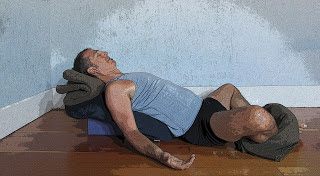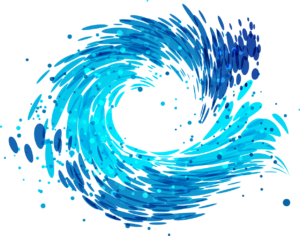by Baxter

We’ve had a few different requests over the past months to talk about the condition of migraine headaches and how yoga might be helpful in addressing them. So Nina and I are splitting up the topic into two focuses. Tomorrow Nina will share with you some ideas around yoga as a possible preventative strategy for migraine headaches (see Preventing Migraines and Other Headaches, Part 1 and Part 2), and today I will tackle the use of yoga during a migraine attack. And we might even get Brad to weigh in on the topic, as he lectures to the pharmacology students at UCSF on medications used to treat migraines. As we talked about the subject during a recent meal, he shared an opinion about treating acute headache attacks with yoga. “F#*k the yoga,” he joked, “Take the drugs!” As he may go into in more detail here later this week, he feels the modern abortive migraine meds are so effective that it might be foolish to not take them, as migraines can take the sufferer out of circulation for a day or more if a severe headache takes hold (see Brad’s Perspective on Migraine Headaches). However, yoga has some effective solutions to offer, too, and there is no reason you can’t combine medication and yoga.
Let’s back up for minute and talk about what a migraine headache is. It is actually important to distinguish this from other forms of headache. In my medical practice, I used to get patients coming in with reported “migraines,” who were actually having more common musculoskeletal headaches that were very strong. They were under the impression that any “bad” headache was a migraine. To clarify the distinction, according to MayoClinic.com:
“A migraine headache can cause intense throbbing or pulsing in one area of the head and is commonly accompanied by nausea, vomiting, and extreme sensitivity to light and sound. Migraine attacks can cause significant pain for hours to days and be so severe that all you can think about is finding a dark, quiet place to lie down.
Some migraines are preceded or accompanied by sensory warning symptoms (aura), such as flashes of light, blind spots or tingling in your arm or leg. Migraines may progress through four stages — prodrome, aura, attack and postdrome — though you may not experience all the stages.”
Since the physiology of the stages of the headache is quite complex, for now I’d like to suggest that the “acute” attack really starts with the “prodrome,” which can be a period of time a day or two prior to the actual onset of the headache symptoms, and can include any of the following signs or symptoms: food cravings, irritability, hyperactivity, stiffness in the neck, diarrhea, constipation, or depression. As you can see from this list, these symptoms could also be associated with other things going on in your life, but the person with migraines begins to notice patterns that can help them predict the coming of headache over time. So, if you are migraine sufferer who has identified these prodrome warnings, this could be the time to pull out some yoga tools best suited to this phase of things. I will get to more specific recommendations shortly.
The second stage mentioned is the “aura,” which, interestingly, the majority of migraine sufferers do not get before the headache shows up. But some do, and it can give them another opportunity to intervene, either with their meds or some yoga or both. The aura usually lasts from 10-30 minutes, and can be in the form of some visual phenomena, like flashing lights, or loss of vision, or pins-and needle-sensations in your arms or legs, or temporary difficulty talking. There are even some people, like Brad himself, who typically only have the aura and do not go on to experience the full-blown headache.
If things progress to a full-blown headache, the headache is typically located on one side of your head and has a throbbing or pulsating quality. It can also include sensitivity sound, light or smell, nausea and/or vomiting, and fatigue. The migraine typically lasts from 4 to around 72 hours. Once the headache subsides, the postdrome period that follows can often leave you feeling fatigued for a day or two. Migraines occur with differing frequencies for different people, and at least one of my students reports a distinct connection with her migraines and her monthly menstrual cycles.
When considering how to use yoga to attempt to short circuit the start of a full blown migraine or to mitigate the severity of the symptoms if you are already at the aura phase, there will be different approaches. In the one to two day prodrome period, taking some time to do a balanced, yet generally gentle asana practice, could possibly stop things from progressing further. The exact practice might be modified if GI symptoms predominate (doing Legs up the Wall, for example, if diarrhea predominates), or if neck pain is your early clue of a possible impending headache (doing gentle neck stretches, for example). In general, I’d recommend milder versions of all of your more active poses, with more focus on a calming connection to your breath than trying to work hard from a musculoskeletal view. And save time for a few restorative poses and perhaps a guided meditation with a stress-reducing focus.
Once you are at the aura stage or onward, the possibility of yoga halting a headache is much less likely, and certain kinds of yoga practices actually could aggravate the headache. Inversions, for instance, are one of the biggest aggravators that my student reported to me, and even lying down flat in Savasana could be too much at times. However, supported poses, where the head is elevated a bit, such as Reclined Cobbler’s pose shown above, can be quite helpful.
Since many headache sufferers head to a quite dark room anyway, setting up in Reclined Cobbler’s pose, using an eye pillow while in there, could potentially speed up recovery times.
I hope you’ve found this helpful, and if you have any recommendations from your own experience, please let us know!
Subscribe to Yoga for Healthy Aging by Email ° Follow Yoga for Healthy Aging on Facebook ° Join this site with Google Friend Connect


I was a long term migraine sufferer until starting my asana practice in 1998. Even though everything I have read has said to avoid inversions, for me they have made me migraine free for years. Whenever I felt the migraine come on, I would use the chair set up for headstand. I would not stay upside down for long but rather do short stints of going up and then coming down. I was very proficient on the chair setup for headstand and that was important.
I hesitate to have you print this comment as I do think that inversions need to be done with a tremendous amount of caution. My wish to share the information is because my migraines were so debilitating that if it can help another sufferer, it may be worth it.
Thanks, Caryn. As Timothy McCall points out in all his writing, yoga therapy, whether for migraines or other conditions, needs to be customized for the individual. So each person needs to work out the best solution for his particular needs and yoga skill level, whether that means working with an experienced teacher or experimenting at home. I'm so glad you found a solution that works for you!
(For those of you who don't know, the set up for chair headstand with rather complicated and definitely needs to be taught to you in person.)
—Nina
Looking forward to your upcoming posts :)